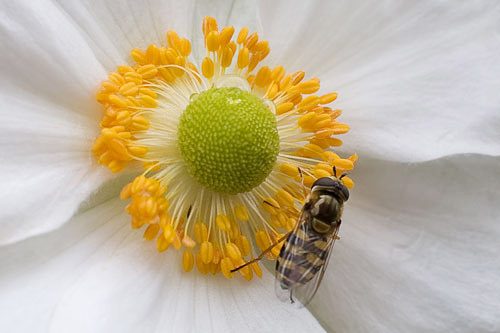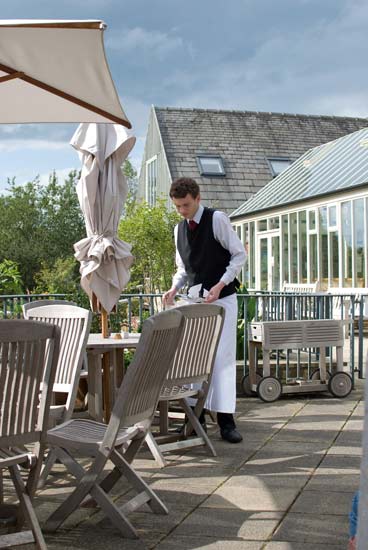Taking a photograph is always a compromise between the available equipment and the quality of the light.
In the middle of the day with the sun overhead, there is plenty of light but things do not usually look at their best. Waiting for the right light isn’t an option if the subject will not hang around, so the compromise is between getting the shot in the midday sun, or getting no shot at all.

Sometimes you can shade the subject from the overhead sun, but it depends upon how big the shade is, or how small the subject is. In this case my body was enough to shade this subject and take out some of the harsh noonday shadows – about which more below.
Diffusers and Reflectors
In sunny conditions photographers will sometimes use sheets of translucent material that are big enough to cast shade over a model and even out the shadows and highlights. The material is stretched over a frame so it can be manhandled and moved into position to block out the specular light from the sun. And photographers will use equally big reflectors to bounce light back into the shadows. Google for the ‘California Sunbounce’ to see some very big diffusers and reflectors and shots of how they are used.
Specular Light
Specular light is light that comes from a small point source. The sun is big, but being so far away it gives a specular light with harsh transitions between light and shade. And it drains the colors from everything it hits. Flattering light is the kind you would get on a bright, clear day with the sun hidden behind a convenient hill, with its light bouncing off a bank of cloud and scattering its rays into a diffused glow.
Shoot Indoors
Shoot indoors by a window that is not in direct sunlight, and your subject will be bathed in directional light. This helps sculpt the subject to give a more three-dimensional look. The nearer the subject is to the window, the faster the fall-off of light and the harsher the transitions from highlights to shadows. Move the subject deeper into the room, and the highlights will taper off more gently into the shadow areas.

Portable Flash
Many professionals use portable flash to take out the harshness of noonday shadows, but that creates its own look, and perhaps you want a more natural look. And flash equipment that can bathe the subject in a gentle light is neither lightweight nor small. The light from a flashgun mounted on a camera is still going to be specular – though to be fair, you can sometimes give the subject a little ‘pip’ of flash to lift the shadows. You can do this by setting the controls on the flashgun to give just a touch of additional light to the subject, rather than having the flash overpower the ambient light.
But getting reliable and consistently repeatable results from flash in any conditions means having a soft, even light. That requires something big to bounce the light from the flash through. This might be a softbox – a sheet of translucent material stretched over a frame, or a translucent umbrella to shoot through. That in turn means a bigger flash – a strobe rather than a little flashgun.
Deciding how much equipment to take and what to leave behind on account of its size and weight is another compromise the photographers must make.
The Light At The End Of The Day
If the mid-day sun in unflattering and your subject will hang around to the end of the day, you can wait. Then you can take advantage of the gentle shadows that strike obliquely and make subjects look more sculpted and three-dimensional. But at the end of the day the light levels will be lower and that brings its own problems.
A Detour Into Film Speed And Grain
If you are shooting film, you have to decide which film to use. Every film (both black and white, and color) has its own ‘look’ but every film is also rated for speed, or to put it another way, for sensitivity. Film manufacturers understand what photographers want and they formulate and produce films in a range from less sensitive to more sensitive to suit different light levels.
And of course there is a trade-off: Slower speed films deliver the smoothest results. Faster, more sensitive film show more grain.
Grain is undesirable because it makes the subject look blotchy, but in the heyday of film, newspaper photographers took that problem in their stride and developed a style built around the grain of certain films. Kodak Tri-X is a black and white film that was and is a favorite with news photographers.
The Advantages of Speed
Faster films aren’t just for shooting in darker conditions. Kodak Tri-X is rated at 400 ISO, which means it is four times more sensitive than a standard film that most consumers would buy for shooting outdoors. That means in turn that a photographer can use a shutter speed that is four times faster than he would have to use with a slow film, which enables him to capture a moment rather than a blur.
Sabastiao Salgado
Sabastiao Salgado is a world-famous photographer who uses Tri-X to document the dignity of man in the most terrible circumstances. He has learned how to make dramatic and remarkable photographs using this fast and grainy film. Google for his name if you are not familiar with his work. It is well worth it.
Changing Rolls
Photographers who shoot film will carry rolls of different film in their camera bags. They will have fast film for action and indoor shooting, and slow film for bright daylight. If you shoot a whole roll of film outdoors then a slow film will be suited to this. But what if you shoot half a roll and then move indoors?
Professional photographers were forever swapping part-exposed rolls to put a more suitable one in their camera. Then they would feed the part-exposed roll back into the camera later. And they would have to remember how many exposures they had taken before they took the roll out. It was a constant source of tension and worry.
Digital Cameras
Now with digital photography we can increase the sensitivity of the sensor just by turning a dial on the camera.
However, as we increase the speed of the sensor, the camera amplifies the signal from the sensor beyond its optimum value. And the trade-off for this extra sensitivity is that along with the increased signal comes increased noise. Noise is the name given to the digital equivalent of grain in film.
Digital Noise
However, digital noise is less attractive than the grain from which fast films suffer. It shows in the photograph as black and colored speckles as well as ‘artefacts’. Artefacts are tiny odd shapes that aren’t there at all in the subject that is being photographed. They are what the camera sensor itself makes when it does its best to fill in the gaps in the signal.

Cameras are getting better though, and in the past ten years the progress has been dramatic, with cameras that can shoot in low light with very little noise. Now photographers can shoot in range of conditions that were once unthinkable.
But despite that, the quality of light is still something that photographers have to take as it is – for better or worse. If it is midday they still have to contend with the harsh overhead light from the sun.
Coffee On The Terrace
A week or two ago, Tamara and I were sitting having coffee on a terrace. It was late afternoon and the sky was dark. But through a break in the clouds the sun shone through at a raking angle and that is when I took this shot.
I like taking photos of waiters – there’s something about the uniform that makes the scene gel. When I saw the exposure in the LCD in the back of the camera, I could see how the low, raking light had sculpted the elements in the scene.
